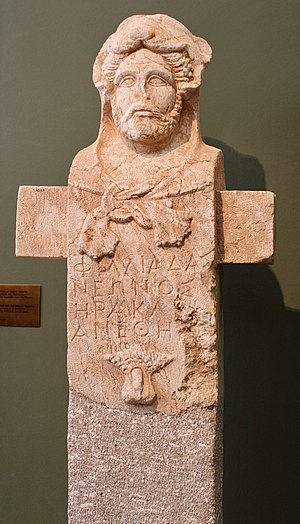Hermeracles: Difference between revisions
mNo edit summary |
mNo edit summary |
||
| Line 1: | Line 1: | ||
{{Lewis | {{Lewis | ||
|lshtext=<b>Hermēracles</b>: is, m., = [[Ἑρμῆς]]-Ἡρακλῆς,<br /><b>I</b> a [[double]] [[bust]] of [[Mercury]] and [[Hercules]], Cic. Att. 1, 10, 3. | |lshtext=<b>Hermēracles</b>: is, m., = [[Ἑρμῆς]]-[[Ἡρακλῆς]],<br /><b>I</b> a [[double]] [[bust]] of [[Mercury]] and [[Hercules]], Cic. Att. 1, 10, 3. | ||
}} | }} | ||
[[File:HermHerakles 2.jpg|thumb|Herma with the head of Herakles (Hermherakles). Museum of Ancient Messene, Greece|alt=Herma with the head of Herakles (Hermherakles). Museum of Ancient Messene, Greece.]] | [[File:HermHerakles 2.jpg|thumb|Herma with the head of Herakles (Hermherakles). Museum of Ancient Messene, Greece|alt=Herma with the head of Herakles (Hermherakles). Museum of Ancient Messene, Greece.]] | ||
| Line 7: | Line 7: | ||
}} | }} | ||
{{Georges | {{Georges | ||
|georg=Hermērāclēs, is, m. ( | |georg=Hermērāclēs, is, m. ([[Ἑρμηρακλῆς]]), [[Merkur]] u. Herkules [[auf]] einem Postamente [[stehend]], Akk. Plur. [[Hermeracles]], Cic. ad Att. 1, 10, 3. | ||
}} | }} | ||
==Wikipedia EN== | ==Wikipedia EN== | ||
A [[herma]] (Ancient Greek: [[ἑρμῆς]], pl. ἑρμαῖ hermai), commonly [[herm]] in English, is a sculpture with a head and perhaps a torso above a plain, usually squared lower section, on which male genitals may also be carved at the appropriate height. Hermae were so called either because the head of Hermes was most common or from their etymological connection with the Greek word ἕρματα (blocks of stone), which originally had no reference to Hermes at all. The form originated in ancient Greece, and was adopted by the Romans, and revived at the Renaissance in the form of term figures and atlantes. | A [[herma]] (Ancient Greek: [[ἑρμῆς]], pl. ἑρμαῖ hermai), commonly [[herm]] in English, is a sculpture with a head and perhaps a torso above a plain, usually squared lower section, on which male genitals may also be carved at the appropriate height. Hermae were so called either because the head of Hermes was most common or from their etymological connection with the Greek word ἕρματα (blocks of stone), which originally had no reference to Hermes at all. The form originated in ancient Greece, and was adopted by the Romans, and revived at the Renaissance in the form of term figures and atlantes. | ||
Revision as of 12:56, 15 May 2021
Latin > English (Lewis & Short)
Hermēracles: is, m., = Ἑρμῆς-Ἡρακλῆς,
I a double bust of Mercury and Hercules, Cic. Att. 1, 10, 3.
Latin > French (Gaffiot 2016)
Hermērāclēs, is, m. (Ἑρμηρακλῆς), buste représentant à la fois Mercure et Hercule : Cic. Att. 1, 10, 3.
Latin > German (Georges)
Hermērāclēs, is, m. (Ἑρμηρακλῆς), Merkur u. Herkules auf einem Postamente stehend, Akk. Plur. Hermeracles, Cic. ad Att. 1, 10, 3.
Wikipedia EN
A herma (Ancient Greek: ἑρμῆς, pl. ἑρμαῖ hermai), commonly herm in English, is a sculpture with a head and perhaps a torso above a plain, usually squared lower section, on which male genitals may also be carved at the appropriate height. Hermae were so called either because the head of Hermes was most common or from their etymological connection with the Greek word ἕρματα (blocks of stone), which originally had no reference to Hermes at all. The form originated in ancient Greece, and was adopted by the Romans, and revived at the Renaissance in the form of term figures and atlantes.

